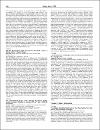The Arrhythmogenic E105A CAM Mutation Dysregulates Normal Cardiac Function in Zebrafish by Altering CAM-Ca2+ and CAM-RyR2 Interactions
| المؤلف | Nomikos, Michail |
| المؤلف | I. Da’as, Sahar |
| المؤلف | Thanassoulas, Angelos |
| المؤلف | Salem, Rola |
| المؤلف | L. Calver, Brian |
| المؤلف | Saleh, Alaaeldin |
| المؤلف | Al-Maraghi, Ali |
| المؤلف | K. Nasrallah, Gheyath |
| المؤلف | Safieh-Garabedian, Bared |
| المؤلف | Toft, Egon |
| المؤلف | Nounesis, George |
| المؤلف | Lai, F. Anthony |
| تاريخ الإتاحة | 2021-10-17T07:34:15Z |
| تاريخ النشر | 2019-02 |
| اسم المنشور | Biophysical Journal |
| المعرّف | http://dx.doi.org/10.1016/j.bpj.2018.11.1316 |
| الملخص | Calmodulin (CaM) is a multifunctional calcium (Ca2+)-binding messenger that directly interacts with the cardiac ryanodine receptor 2 (RyR2), a large transmembrane Ca2+ channel that mediates Ca2+ release from the sarcoplasmic reticulum to activate cardiac muscle contraction. Genetic studies have reported CaM missense mutations in individuals with history of life-threatening arrhythmogenic heart disorders. A recent clinical report identified a novel, long QT syndrome (LQTS)-associated CaM mutation (E105A), in a child, who experienced an aborted first-episode of cardiac arrest. Herein, to determine the functional consequences of the E105A mutation in vivo, we introduced this mutation into human CaM sequence and we injected synthetic mRNA encoding CaMWT and CaME105A into zebrafish embryos. Although expression of CaMWT and CaME105A proteins in zebrafish did not affect the normal embryo development, a slight change in the heart morphology was observed, with ∼31.5% of the CaME105A-injected zebrafish exhibiting extended hearts. Furthermore, analysis of the cardiac activity of the zebrafish ventricle revealed that CaME105A mutant-injected larvae displayed irregular pattern of heart beating in comparison to the median of the CaMWT and control groups, resulting to an increased arrhythmic potential in these embryos. In addition, the average heart rate was significantly increased in this group (∼160.5 beats per minute (bpm) vs ∼152.5 bpm of control group). In vitro Ca2+-binding studies revealed that the C-domain of CaME105A mutant exhibited a ∼10-fold reduced Ca2+-binding affinity compared to CaMWT. Finally, the functional effect of E105A mutation on RyR2 activity was assessed by a [3H]ryanodine binding assay and suggested that CaME105A mutant shows a dramatically reduced inhibition of ryanodine binding to RyR2 compared to CaMWT. Our findings suggest that LQTS-associated E105A CaM mutation dysregulates normal cardiac function in zebrafish by altering both CaM-Ca2+ and CaM-RyR2 interactions. |
| اللغة | en |
| الناشر | Elsevier |
| الموضوع | Zebrafish beats per minute |
| النوع | Article |
| الصفحات | 240a |
| رقم العدد | 3 |
| رقم المجلد | 116 |
تحقق من خيارات الوصول
الملفات في هذه التسجيلة
هذه التسجيلة تظهر في المجموعات التالية
-
أبحاث الطب [1819 items ]



